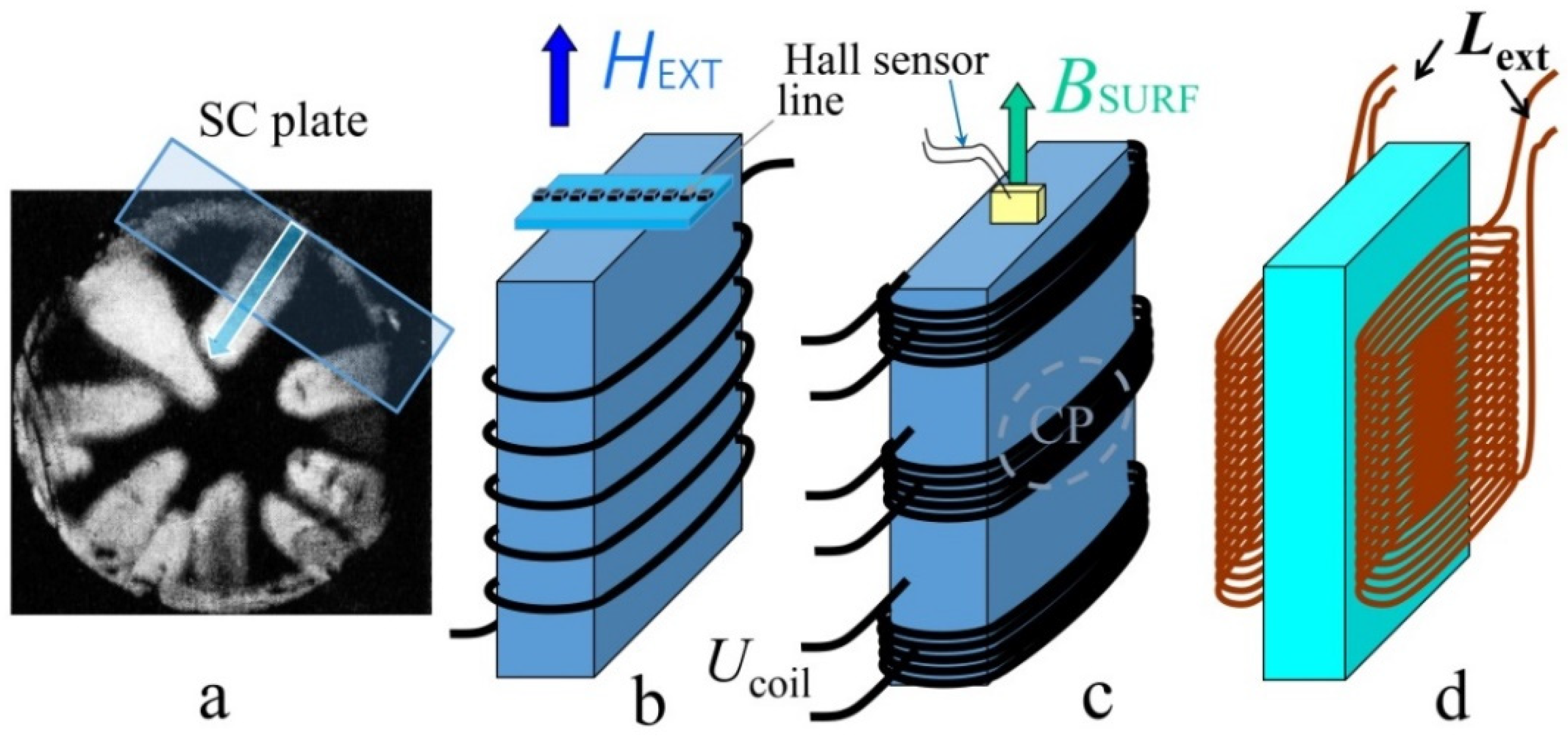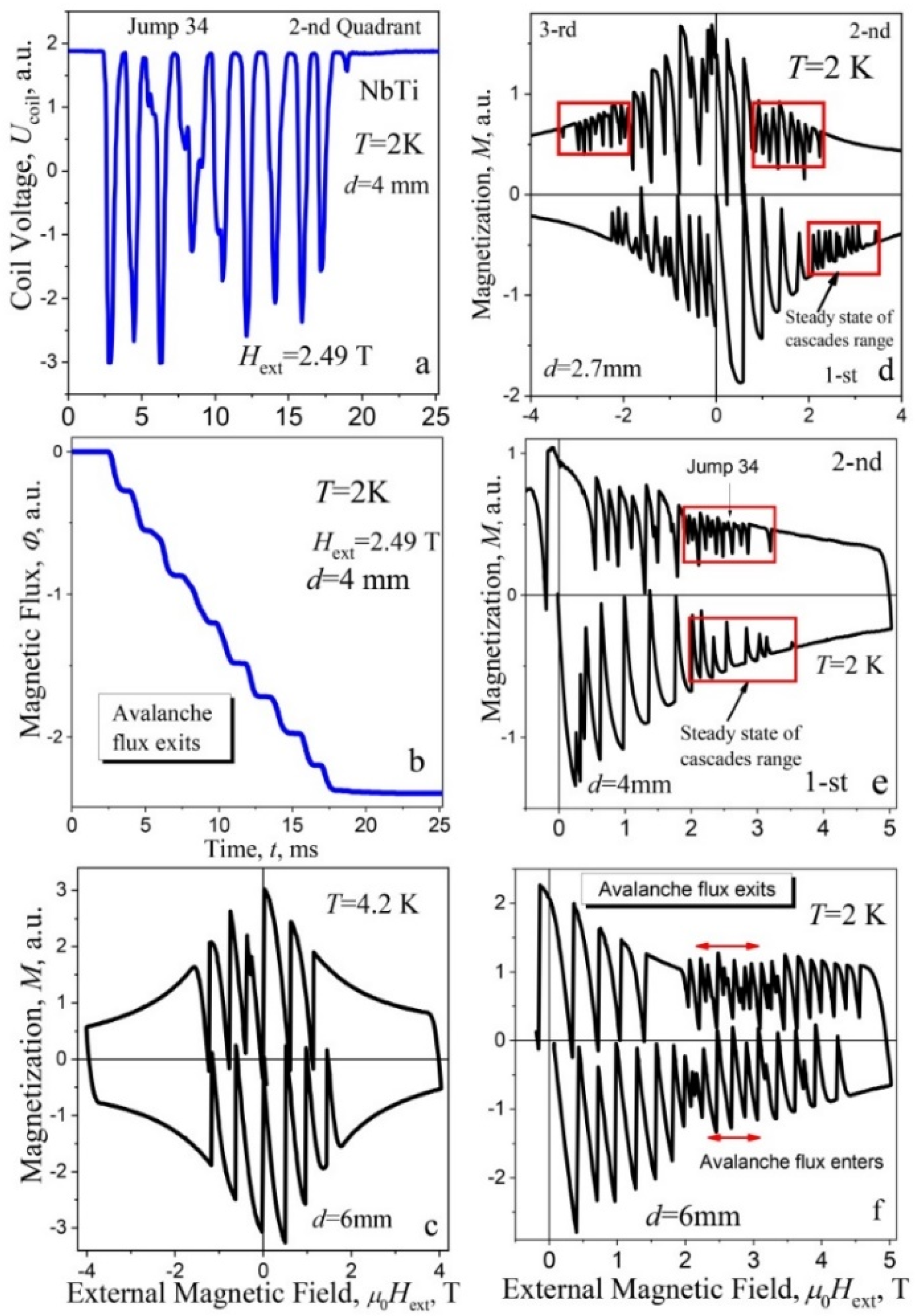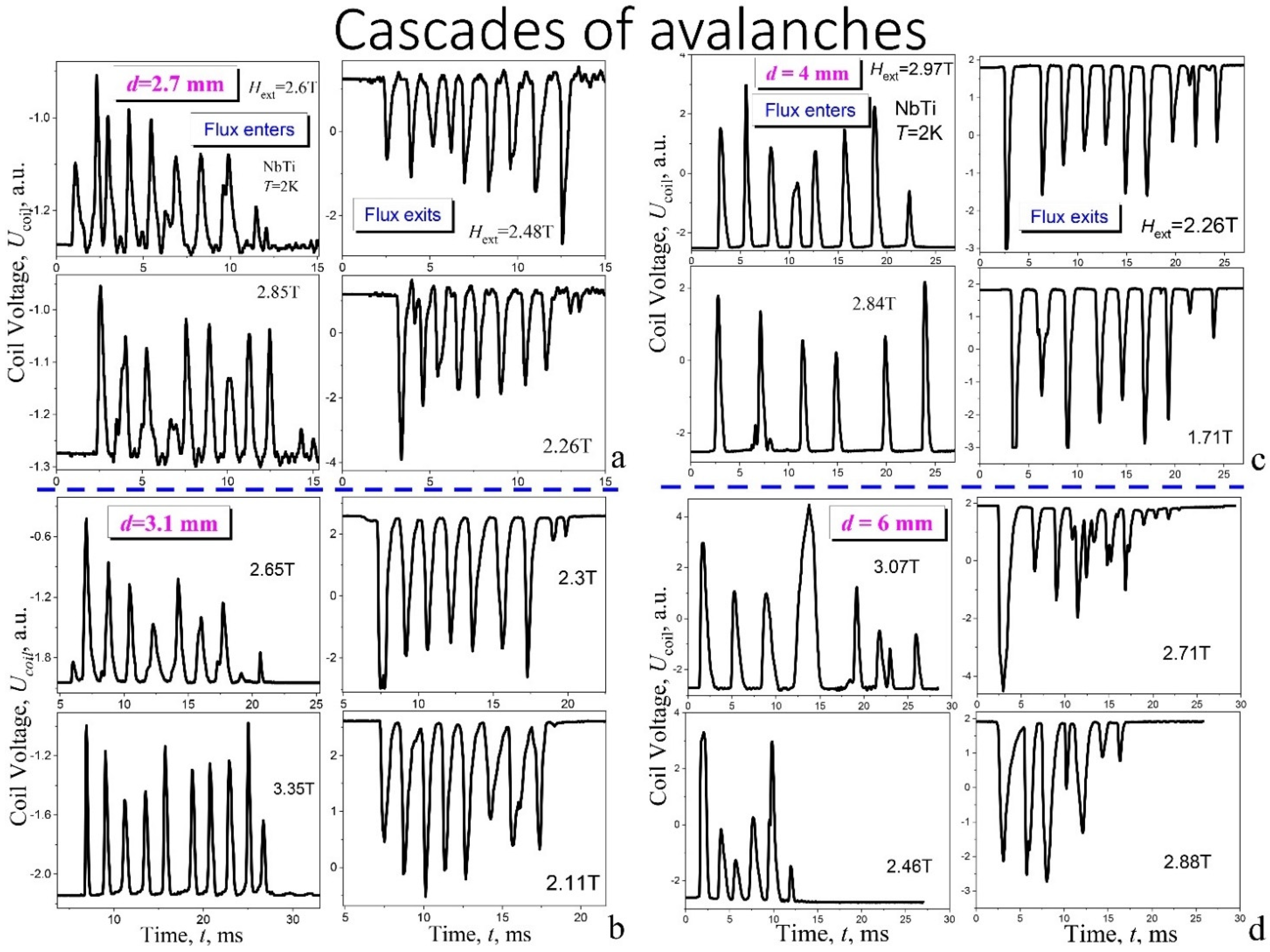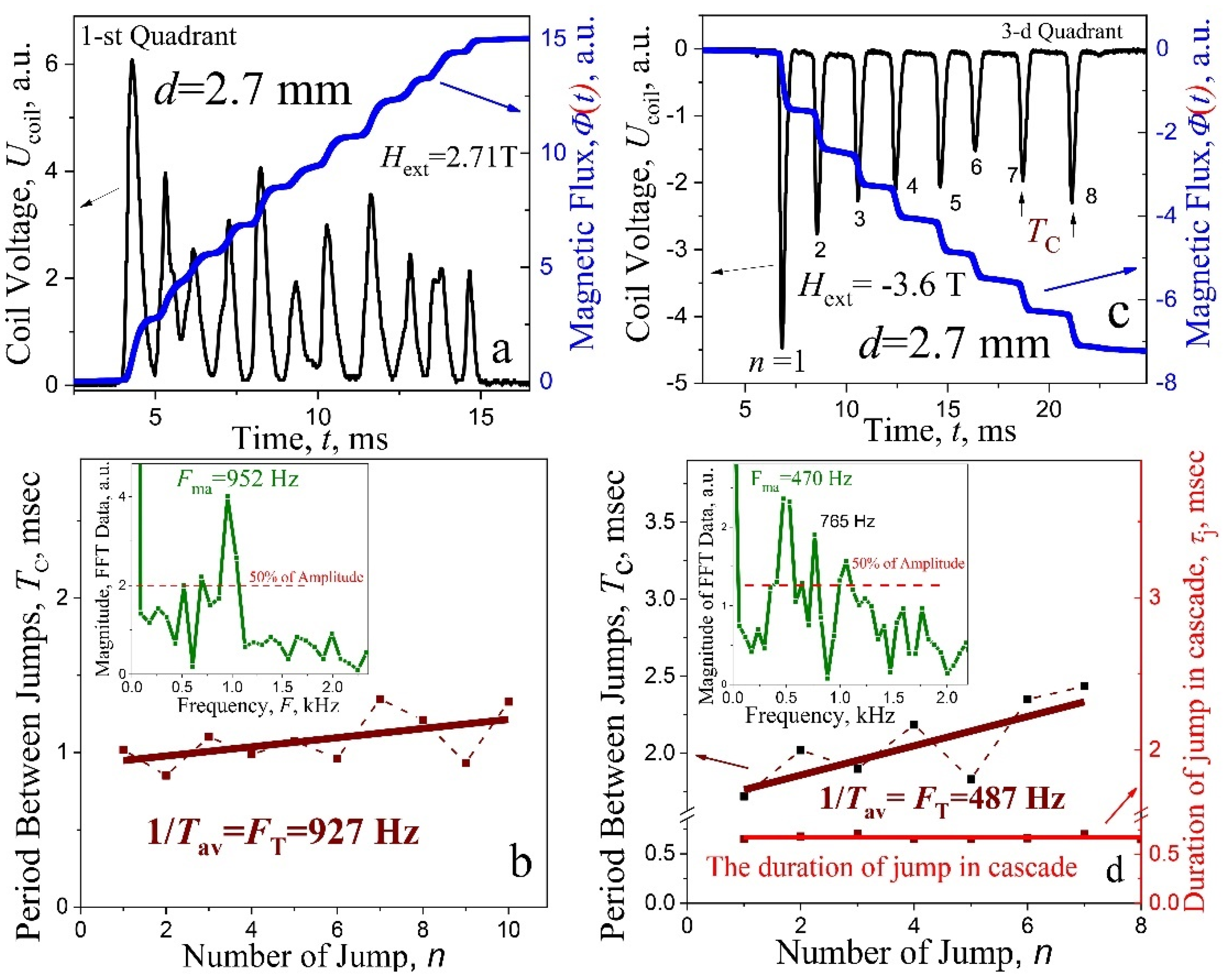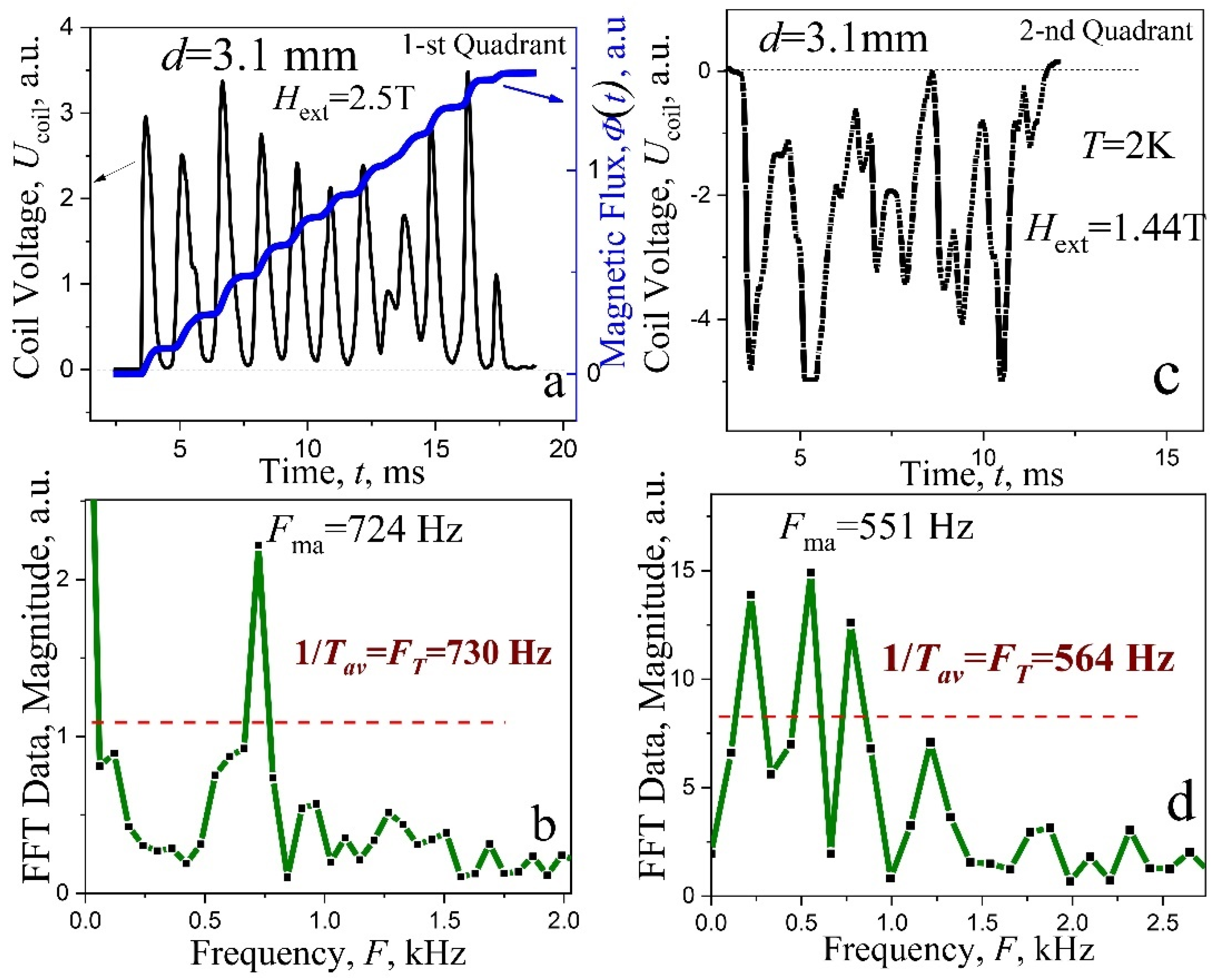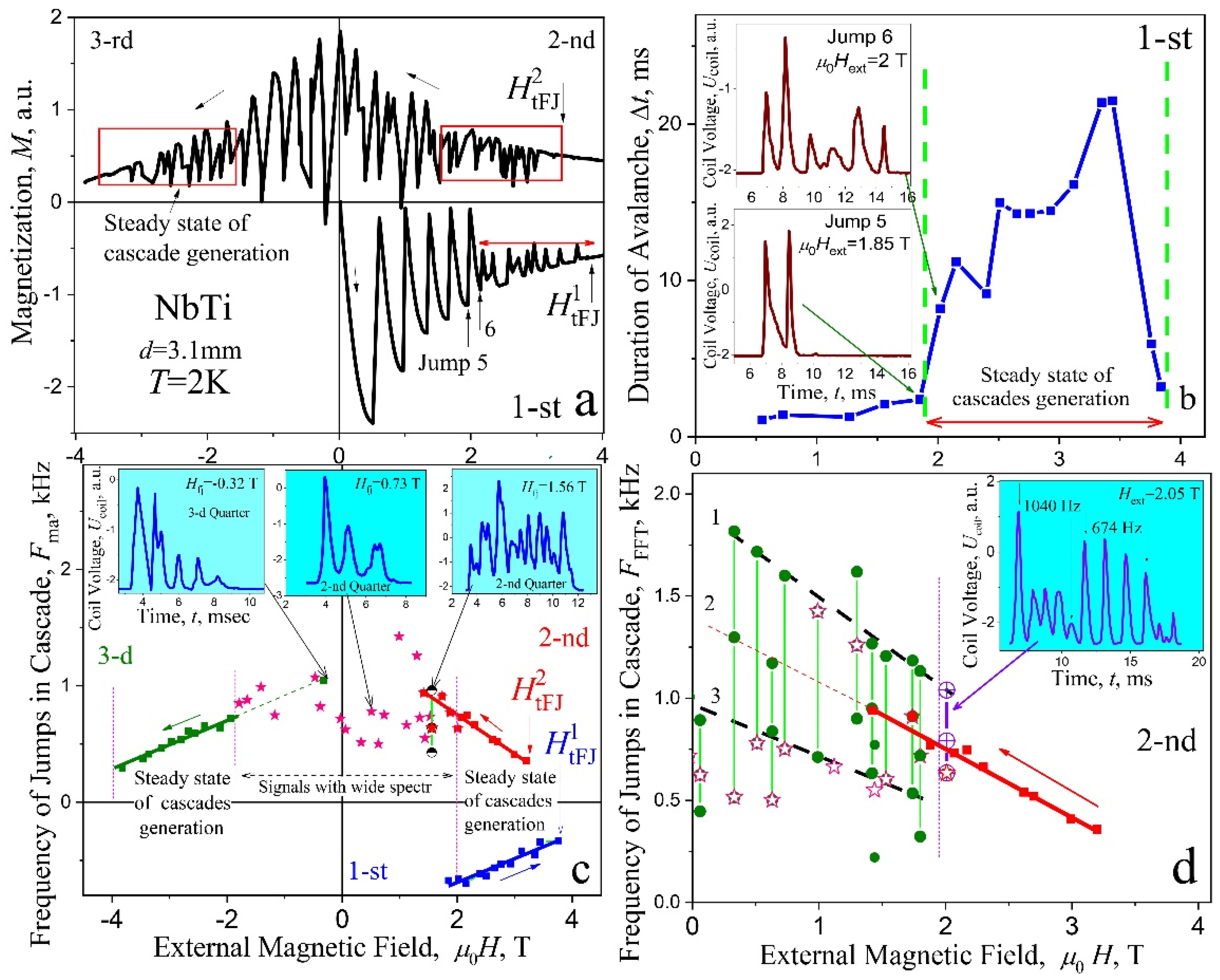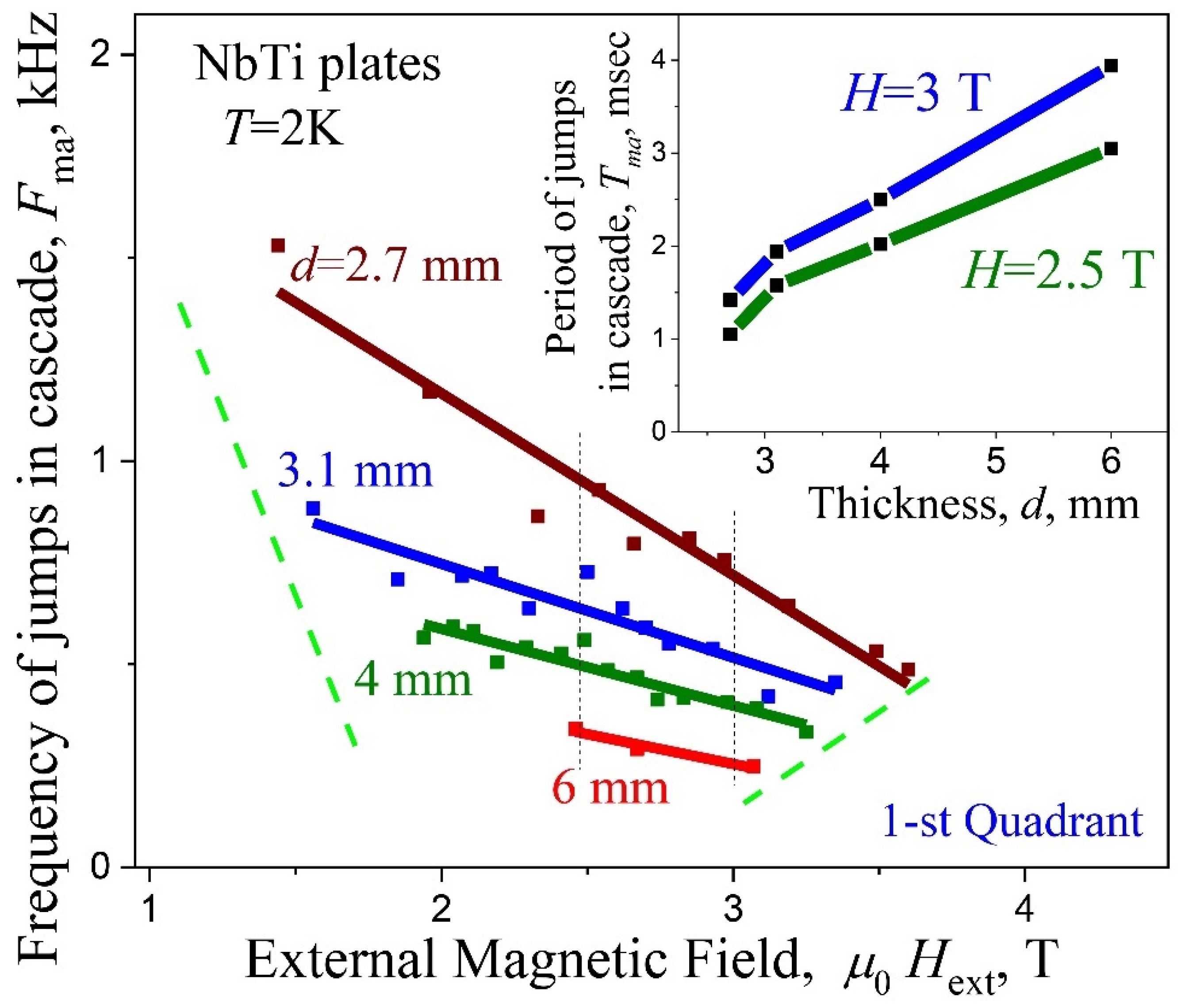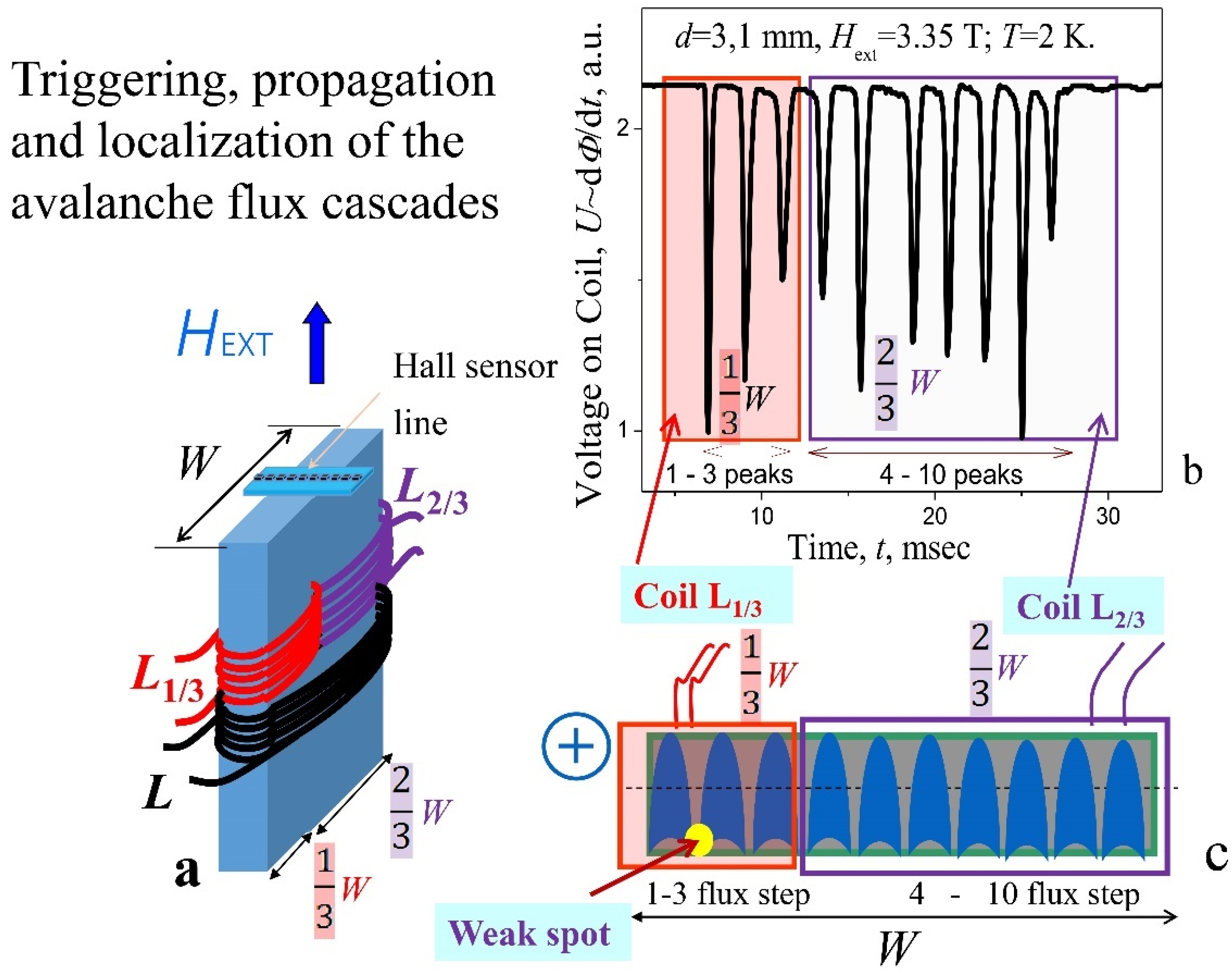3.2. The Flux Step-Like Structure in Avalanche Cascades
Periodicity analysis. To study the patterns of stepped structure of the flux Φ(
t) (
Figure 2b) under the influence of external factors, its derivative
Ucoil(
t) should be analyzed, which allows to consider changes in the repetition period
T of individual avalanche pulses (flux portions) in a cascade, or to analyze their characteristic frequencies
F (pulses) of their repetition. For simple harmonic signals, this is, in principle the same, since the relationship between these quantities is trivial:
T = 1/
F. In the case of the studies performed here, it is not always easy to visually determine the period from the signal structure. This is especially true for the region of relatively weak magnetic fields −1.5 T–0–+1.5 T in the second and third quadrants.
Let us first consider the periods
Tc between peaks of voltage
Ucoil(
t) in cascades for different forms of studied signal. In
Figure 6a,c and
Figure 7a,c, some characteristic and their detailed analysis, for 2.7 mm and 3.1 mm samples, respectively, are shown, with the voltage impulse
Ucoil(
t) (left ordinate) inherent to a cascade at the avalanche, and a multi-step “stairway” structure of magnetic flux Φ(
t) (right ordinate) in a screening (a) and a trapping (c) regime. Two types of signals have been selected here: in the first case (a) avalanche impulses overlap slightly (the end of the “crown”,
Figure 4a), in the second—
Figure 6c—avalanche impulse are spaced (separated) in time. The latter case is typical for avalanches in strong magnetic field, near the boundaries of the region of instability of the critical state.
The periods
Tc between jumps in cascade vs number of impulses
n (or steps) are shown in the main frame of
Figure 6b,d, left ordinate. As follows from presented data, the screening and trapping regimes
Tc increase over time in both cases. The experimental points are scattered around the straight lines, constructed with least squares method. The values of the frequency pulse
FT = 1/
Tav in cascades (
Tav is the average period) are given below the lines. Importantly, a similar period is observed in three quadrants for the plates of different thicknesses, in the range of steady state of cascades generation.
The increase in the
Tc period with time can be associated with an increase in the dissipation of the induction-current system in the critical state as the flux enters the superconductor. Such increase is characteristic for oscillatory with an increase in the attenuation. Structured cascades with a uniquely visually identified frequency rarely appear during magnetization reversal in the range of 0–±1.5 T, in the second and third quadrants. Here, avalanches exhibit, mainly, a complex structure. An example of the signals for a plate with a thickness of
d = 3.1 mm, where it is difficult to visually assess the main period of
Tc and the corresponding frequency, is presented in
Figure 7c. Here, spectral analysis helps to establish the frequency components of the spectrum and, if necessary, to determine the appropriate periods.
Spectral analysis. With an increase in the magnetic field, the structure of avalanche pulses passes smoothly from a single pulse with small oscillations (
Figure 5a) to almost periodic oscillations limited in time (
Figure 3). Proper analysis of the data requires information on the amplitude and frequency of the signal spectrum components, i.e., on the amplitude-frequency spectrum and thus, fast Fourier transformation (FFT) from the Origin program (OriginLab Corporation, Northampton, MA, USA) was utilized in the analysis of the
Ucoil(
t) spectra in the entire region of instability of the critical state. The characteristic
FFFT frequencies in the signal spectrum, determined with this package and compared with the values of the pulse repetition frequency
FT, obtained directly from the average period
Tav, exhibited its good efficiency (see, the inset in
Figure 6b,d and
Figure 7b,d—the amplitude spectra of avalanche signals with characteristic
FFFT frequencies). The values of the pulse frequency gained from the average period
FT for plates with a thickness of
d = 2.7 mm and 3.1 mm, are presented in
Figure 6 and
Figure 7, respectively. The spectrum component with the maximum amplitude presented in
Figure 6b corresponds to the frequency
Fma = 952 Hz, which is in good agreement with the frequency value estimated from the average period:
FT = 927 Hz. The spectrum shown in the inset in
Figure 6d is more complex. Here, there is a fundamental frequency
Fma = 470 Hz with a maximum amplitude, which practically coincides with the frequency
FT = 487 Hz. In addition, the spectrum contains two more components, the amplitude of which exceeds the amplitude level of 50% of the fundamental harmonic. A good agreement of spectral analysis is presented in
Figure 7:
Fma = 724 Hz and
FT = 730 Hz (b) and
Fma = 551 Hz and
FT = 564 Hz (d).
It should be noted that the signal
Ucoil(
t) presented in
Figure 7c exhibits a spectrum with three component frequencies (
Figure 7d), with similar amplitude values. This is definitely due to the strong beats in the signal. Apparently, the presence of such frequency components, with close amplitude values, leads to “jumps” in the experimental dependences of the
Tc periods vs number
n (
Figure 6b,d) around the approximating straight lines. The data indicate that the harmonic
Fma, with the maximum amplitude in the signal spectrum, is suitable for analyzing the effect of external influences and parameters of a superconducting plate on the phenomenon of multi-steps magnetic flux dynamics in the entire region of instability of the critical state.
The results of studying signals from avalanches for three quadrants in a plate with a thickness of 3.1 mm are shown in
Figure 8 and the features of the hysteresis loop
M(
Hext) associated with the excitation of cascades are shown in
Figure 8a. A stepwise decrease in the amplitudes of magnetization jumps Δ
M is clearly expressed in the region of cascades for three quadrants of hysteresis loop and for all thicknesses (
Figure 2d,e), which is a result of the excitation of cascades. This is evidenced by magnetic field dependence of the avalanche duration Δ
t(
H), shown in
Figure 8b (main frame) and by their structures in the region of the amplitude step in field dependence of magnetization. The avalanches in this place [inserts into (b), jump 5 and 6] undergo threshold changes. During the sixth avalanche, the origin of multistage nature of the flux dynamics sharply increases, while the duration of the avalanche suddenly increases by three times, and the incoming flux is divided into six portions spaced in time (jump no. 6). The explanation of the step in magnetization is quite simple. Step-like behavior is associated with a change in the localization of the avalanche spot of the incoming flux and with Hall sensor method of induction measurements, where a local field change at the center of the surface is registered. During avalanche no. 5, the magnetic spot was located mainly in the central part, under the sensor. In the case of cascades (avalanche 6), the magnetic flux was dispersed like a comb of six teeth along the entire side of the plate. In this case, the level of induction under the sensor becomes significantly smaller.
Here, it is appropriate to emphasize practical implication of the importance of phenomenon of cascades at avalanche in the volume of superconductors: the incoming avalanche flux is dispersed in time and becomes non-localized in high field region. One of the main problem challenges in superconducting applications is to avoid thermomagnetic breakdown of critical state (quench) and as a result, the sudden disappearance of beneficial properties. To avoid creation of conditions for non-localized place of quench is one of the important practical issues solved by technologists today [
38]. The discovery of a multi-steps magnetic flux entrance/exit at thermomagnetic avalanches in the plates of hard superconductors could make a difference in the case of applications of electric motors or generators built with superconducting elements in the form of plates. In the plates with certain thicknesses, this phenomenon reduces the risk of failure at maximum loads.
The evolution of the avalanche structure in the first quadrant (shielding mode) was previously analyzed in detail, using the example of a plate with
d = 2.7 mm (
Figure 4a and
Figure 5). Now, we will consider the properties of cascades in the second and third quadrants. The instability of the critical state is observed here in a field range from +4T to −4T (
Figure 8a,c). The frequency values
Fma for the components with the maximum amplitude in the signal spectra are shown in
Figure 8c (main frame). The
Fma frequencies, in the range of high magnetic field ±2–±4 T (steady state cascades generation), are marked by full squares (■). Here, the frequency decreases linearly with an increase of magnetic field for all quadrants. Such behavior of the
Fma may be interpreted as a result of increasing of dynamical dissipation of critical state and by decreasing of the avalanche start velocity as a result of the critical current density
jc(
Hext) decreasing.
The stable cascades with a small number of flux steps ΔΦ appear in the field region −2 T–+2 T, as it is shown, for example, in the left and in the center inserts at the top of
Figure 8c. The data in the main panel, described by asterisks (☆), indicate the frequencies
Fma. The signal
Ucoil(
t) exhibits here a complex structure with a wide spectrum (
Figure 7c,d) and it seems that, in such a case, determination of the fundamental harmonic
Fma (asterisks in
Figure 8b) is very difficult, if it is possible at all. Therefore, an attempt was made to present, for each signal
Ucoil(
t), the frequencies of all spectrum components with amplitudes higher than 50% of the maximal value. The result for the second quadrant is shown in
Figure 8d. Here, the frequencies
Fma, described by asterisks (☆), as in
Figure 8c, are shown, together with frequencies of the harmonics with slightly lower amplitudes, described by the full circles (●). In the field region
H 2 T, one can visually distinguish between certain lines, designated with the numbers 1, 2, and 3, on which most of the experimental points lie on the array. Field dependence for lines 1 and 3 is similar to that of line 2, which is a continuation of the straight line
Fc(
Hext) from the field range of steady state generation of cascades. In terminology taken from other branches of physics, the lines 1, 2, and 3 can be described as follows: Frequency “level” 2 (line 2) for
Fma(
Hext) corresponds to the dynamic state of the flux with steady state generation of cascades and it splits in a magnetic fields below 2 T into two “levels”, corresponding to the states of lines 1 and 3. Such behavior can be expressed as a certain degeneration of the “frequency levels” on lines 1 and 3, which occurs in a magnetic field µ
0Hext 2 T.
We managed to observe, for one of the cascades in the transition region (inset in
Figure 8d), a signal, occurring at the boundary in
Hext = 2.01 T, where two frequencies marked by crossed open circles (⊕) are clearly visually present: the upper
F = 1040 Hz belongs to the straight line 1 and the lower frequency
F = 674 Hz, which falls on line 2 for frequencies corresponding to stable cascades. Analysis of the avalanche flux dynamics in the second quadrant indicates the presence, in the region of weak fields (µ
0Hext 2 T), of some effective mechanism, leading to the appearance of electromagnetic radiation of a complex spectral composition. In a thinner plate with
d = 2.7 mm, the field dependences of the frequency
Fma, which characterize the avalanche flux dynamics look similar—
Figure 9a. In the range of steady state generation of cascades, the frequency dependences
Fma(
Hext) for the first and third quadrants practically coincide. The data for the second quadrant also exhibit a significant “scatter-rocking” of the experimental values of
Fma(
Hext) and are lowered, in the same field range, in comparison with those in the first quadrant. Two measurements are presented for the second quadrant [marked by two different kind of stars (☆)] in order to show the repeatability and rocking range of experimental data in complex spectra.
The amount of magnetic fluxes in avalanches significantly differs between the first and the second quadrant (
Figure 9b): in the same magnetic field much more flux enters in the shielding mode than exits in the trapping mode. Moreover, in the latter case, experimental values for the exiting fluxes are extensively scattered, as do the values of the frequencies in the dependence
Fma(
Hext). It should be noted that the amount of magnetic fluxes decreases exponentially with increasing external magnetic field for the 1st quadrant (
Figure 9b) as well as the absolute values of voltage impulse (
Figure 4b).
Figure 9c shows the period
Tma = 1/
Fma between jumps in cascade as a function of magnetic field for various quadrants. It becomes clear here, the pulse frequency in the inductive signal depends linearly on magnetic field.
The role of plate thickness. Magnetic field dependence of the jump frequency
Fma for cascades in screening regime (1st quadrant) for the plates with various thickness
d is shown in
Figure 10. It can be seen from these data that the region of the magnetic field, where cascades are stably realized, rises up along the frequency axis when the plate becomes thinner. At the same time, the range of magnetic fields and frequencies of cascades is significantly expanded. Insert in
Figure 10 shows the dependence of period 1/
Fma between jumps in cascades as a function of plate thickness along vertical lines at µ
0Hext = 2.5 and 3 T in the main frame. The period between avalanches inside cascades increases almost linearly with increasing plate thickness. It may indicate on the functional role of the plate thickness in triggering of cascades.
3.3. Triggering, Propagation and Localization of the Avalanche Flux Cascades
The place of avalanche origin. An avalanche appears, usually, in a small volume, almost at a point compared to the size of the plate, and a bundle of vortices trapped at pinning centers can stimulate an avalanche. The process of magnetic field penetration constantly accompanies jumping of the bundles [
3,
4]. Simultaneous registration of the signal at different levels along the height of the plate (
Figure 1c) opened possibility to find the level where the signal appears first and to estimate the propagation velocity of the disturbance along the magnetic induction line. The analysis of the time delay Δ
tdelay, between signals (more than 60 signals) from the avalanche beginning, allowed us to fix the most probable place of their origin. Statistics showed that the avalanches originate in 68% near the central region (CP,
Figure 1c) of the lateral surface of the plate, and in 32% only—at its edges. This result agrees with calculation of field penetration into the plate [
39]. In the central part, the screening is maximal, the magnetic field pressure is the highest, and, accordingly, the initiation of instability is most likely here. An attempt, to find side surface, where an avalanche originates (and to feel from which side a separate jump of the flux enters), using two external inductive sensors on different sides of the plate (
Lext,
Figure 1d), while recording signals, was unsuccessful. It means that, the delay (or accelerates) of the avalanche onset on one of the lateral surfaces and the asymmetry of scattering field dynamics on opposite sides of the plate, during the stepwise entry of the avalanches, were not detectable. A beautiful shaped cascade when the signals from two sensors were added and its almost complete compensation to the noise level, when they were subtracted, was observed. It should be noted, here, that, in wide coils, covering a significant part of the side surface of the plate, the stages looked to be more structured. This may be due to the fact that the origin of the cascades travels along the vertical or along the lateral surface and their appearance is somewhat different in different sections. Most probable speed of propagation of the disturbance along the direction of the magnetic field,
V||, was determined on the basis of statistical data analysis and it was found that, it corresponds to the maximum velocity distribution function. The velocity reaches
V||max = 0.5
h/Δ
tdelay = 286 ± 20 m/s, where
h is the plate height.
Spatial-temporal cascades behavior. In order to establish the location of the parts of the incoming flux on the central section of the plate, the pickup coils for the avalanche flux registration were placed on superconducting plate (
Figure 11a) in the whole plate’s width (
W) − (
L), in the 1/3
W (
L1/3) and 2/3
W (
L2/3). In order to cover individual sections of the plate, a hole with a diameter of 0.7 mm was made for the placement of inductive sensors
L1/3 and
L2/3. Self-consistent cascade for the plate with
d = 3.1 mm, recorded at
T = 2 K in µ
0Hext = 3.35 T simultaneously by three coils
L,
L1/3, and
L2/3, is shown in
Figure 11b. Full signal registered by coil
L is divided proportionally between the coils
L1/3 and
L2/3, confirming spatial separation of impulses in the cascades along the lateral surface of the central section. Schematic view of possible spatial localization of successive flux avalanches (steps) in the form of fingers is shown on the cross-section of a plate orthogonally to magnetic field (
Figure 11c). The numbers given in
Figure 11b,c indicate the sequence of avalanches occurrence. The individual flux pulses are shown here in the form of “fingers” since it is known [
13] that the shape of avalanche spots transforms at low temperatures from round at
T = 4.2 K to “finger-like” at 1.8 K. “Fingers” of avalanches in the scheme (
Figure 11c) cross the plate all the way to the opposite side, rather than stopping at its middle, which is in agreement with the results of experimental studies of the distribution of surface induction—signal registered by an array of the Hall probes (
Figure 1b) before and after appearance of thermomagnetic avalanches in increasing and decreasing external magnetic field [
15]. Here, local induction inversion as a result of a thermomagnetic avalanche over the entire thickness (
d = 4 mm) of the studied NbTi plate occurred already at
T = 4.2 K (Figure 3b,c from Ref. [
15]), which may indicate that the avalanche front crosses the entire plate. However, an unambiguous answer can only be given by direct observation of the flux front using magneto-optics.
Simulation of avalanches movement in superconducting films [
25,
26] indicates that the avalanche front tends to displace the superconducting current from the surface to the opposite side of the sample. It means that the superconducting current is pushed out of the hot zone of the avalanche finger into the cold zone of the superconductor [
40]. In shielding mode (diamagnetic induction), an appearance of “paramagnetic” profile is expected if the flux front manages to cross the middle of the sample, which takes place in the simulation. This is exactly what was observed in the experiment (Figure 3b from Ref. [
15]).
3.4. Possible Mechanism of Cascades Triggering
The linear dependence of the cascades period on plate thickness suggests that the period of step structure of magnetic flux avalanche dynamics Φ(t) in cascades may be controlled by plate thickness as well as the limitation of path length of the front of an individual avalanche finger in the cascade, introduced by plate thickness, can lead to the appearance of a certain sequence of excitation in the induction-current system of the critical state of the superconductor.
Let us consider a possible scenario of cascades triggering. When the critical induction drop Δ
ΒFJ is reached, the initial flux step (finger) in cascades can be stimulated in the superconductor critical state layer by small jumps of the flux bundles. Penetrated first finger’s flux redistributes current in the sample, and thus creates weak spots for penetration of the consequent avalanche finger, etc., [
40]. Weak spots appear in the concave corner (Figure 26 from Ref. [
41]), near the finger’s gate (
Figure 11c), where the current lines looming (become thicken) occur. Subsequent avalanches in the cascade can trigger a weak spot by a locally amplified pulse of a magnetic or electric field [
42] and, accordingly, a current Δ
J due to deceleration of the previous finger of the flux reaches the opposite side of the plate. The plate in this way can show its “resonator” properties.
The expansion of the range of magnetic fields, where cascades stably arise, with decreasing plate thickness, as well as the disappearance of this phenomenon for plates with
d 6 mm (
Figure 10), testifies in favor of the important role of finger’s-type flux reflection from the opposite side (resonator properties of the plate) in the process of self-excitation.
Let us try to estimate the time it takes for the flux front to cross our plate in order to compare it with the period of multistage “stairway” structures. The dynamics of the avalanche front in conventional superconductors Nb and NbZr at a temperature of
T = 1.4 K and in a magnetic field of 0.2 T was studied by the magneto-optical method [
14] and time dependence of path traveled by the avalanche front is shown here. The magnetic flux front runs a distance of 3 mm in 0.4 ms for NbZr and in 0.6 ms for Nb, respectively, which is plotted in
Figure 9c, presenting the data on the pulse periodicity in cascades for a 2.7-mm thick plate, corresponding well to the values of the periods of cascades. Hence, we can conclude that the plate, showing its “resonator” properties, can serve as a metronome that sets the period of magnetic flux dynamics in plates and lead to a multi-step “stairway” structure of flux Φ(
t). Existence of avalanches in the form of a cascade of almost equidistant events can be unambiguously confirmed by simulating it only. However, it is quite plausible since penetrated flux redistributes current in the sample, and thus creates weak spots for penetration of the consequent avalanches, etc., [
40].
3.5. Impact of Magnetic Prehistory
The change in the profile of magnetic field in the plate, with the change from increasing to decreasing field in the second quadrant, leads to a displacement of the boundary of critical state
H2tfj stability region into weaker fields (
Figure 8b), as compared to the first quadrant (
H1tfj). The physical reason for this is a decrease in the critical current density due to the trapped flux, since the trapped flux increases, in a given external magnetic field, the average effective field in superconductor, as compared to that in shielding regime [
43]. The profile of magnetic field induction can affect the spectral characteristics of the avalanche dynamics of the front flux. The magnitude of induction gradient in superconductor sets the impulse to the flux in the avalanche at the “start”. The subsequent movement of the avalanche front in the plate passes along the induction relief formed before this, with the exception of the first avalanche in the screening mode. A schematic representation of Bean’s magnetic induction profile
B(
x) in a plate corresponding to situation before first flux jumps in screening regime and for trapping regime in strong magnetic field (field ramping backward) is shown in
Figure 12 [left side of (a) and (b), respectively]. The result of avalanche flux entry/exits process is presented on the right side of
Figure 12a,b. Here, a cross-section of a plate perpendicular to magnetic field is shown.
Screening regime. Avalanches appear above the field of the first instability
Hext H1fj (
Figure 12a) and the regime of cascades generation appears at the first avalanche, as it was depicted in
Figure 5a. The critical current is maximal here, the pressure is high, and the flux front speed is high. Thus, a large amount of magnetic flux enters the region of the Meissner state of the superconductor (
Figure 12a, right side). The central strong avalanche appeared, apparently, in the form of a finger. However, when its propagation was limited by the second side of the plate, the width of the finger under the pressure of the flow of vortices began to increase in the orthogonal direction, occupying a significant part of the plate. According to the signal structure (
Figure 5a), subsequent flux fingers in the cascade were weaker. As the magnetic field increases, the critical current density decreases. Therefore, in the next cascades, the amount of flux that entered at the first pulse decreases, and to fill the plate with the flux, the number of subsequent avalanches in the cascade increases.
Trapping regime. The induction-current structure of the critical state in the flux trapping mode is fundamentally different from that in the screening mode. With shielding, only one critical current direction is present (
Figure 12a, right side). In the second quadrant, due to a change from increase to decrease of external field, a second current loop in the opposite direction appears in the current structure (
Figure 12b, right side). In this case, a boundary arises that separates these counter currents. In Bean model it is a straight line. In reality, due to the inhomogeneity of the pinning in the superconductor or the stochasticity of the vortex dynamics, this boundary is a jagged line [
44,
45,
46,
47]. The dynamics of this jagged (zigzag) current boundary can lead to turbulent formations along the front and circular currents (vortices). Moreover, these vortex formations can also keep the opposite direction of the circulation of currents. Therefore, the destruction of the critical state and the breaking the flux off a dome-like profile of induction can be accompanied by a dynamic “mixture” of oppositely directed electromagnetic fields, which leads to a more complex spectral composition of the induction signal than in the screening mode. This electromagnetic mixture, superimposed on the “resonator manifestations” of the plate, can strongly influence the triggering of first finger and steady state of cascades generation. As a consequence, a scatter-swing of experimental points in field dependences of the
Tc(
Hext) periods (
Figure 6b,d) and frequencies in the
FFFT(
Hext) spectra (
Figure 8c,d) may appear.
The possible physical reasons of the complicated signal spectrum, accompanying avalanche flux dynamics, can be associated with the structure roughness of the moving flux front and inhomogeneous relief of induction. The electromagnetic radiation, accompanying the avalanche, is formed as a result of the acceleration and deceleration of individual sections of the front of moving flux, during interaction with fixed vortex bundles, followed by their separation from the pinning centers. A non-monotonic increase in the amount of flux entering the superconductor may occur and a moving flux can sweep away pinned flux hills (vortex bundles), like a tsunami, as simulation of thermomagnetic avalanches demonstrates [
40]. In this case, the magnitude of the pinning inhomogeneity determines the level of electromagnetic “noise”, accompanying the flux dynamics. The magnitude of inhomogeneities can decrease, with an increase in magnetic field, due to a decrease in the critical current density. In the third quadrant, when the direction of the external field changes, regions of the superconductor arise, where the magnetic field induction has the opposite direction of the field lines compared to the trapped flux. In the fields of 0–−2T, this can be strongly reflected in the excitation conditions and, accordingly, in the spectrum of avalanche pulses. In stronger fields µ
0Hext ≥ −2 T, the induction of external field direction only remains in the plate and its distribution is similar to that in the first quadrant [
43], leading to the coincidence of frequency dependences
Fma(
Hext) of cascades (
Figure 9a) for two quadrants.
